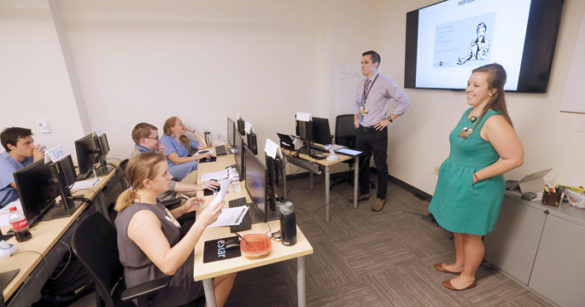
Aspiring medical students Lauren Holroyd and Julian Genkins took a break from academics after earning their undergraduate degrees and went to work for the health care software company Epic, based in Verona, Wisconsin. Although they did not know each other at the time, they would both end up at Vanderbilt University School of Medicine (VUSM) where they would put their Epic expertise to work.
Holroyd, who majored in neuroscience and sociology at Vanderbilt University, worked for Epic from 2012-2014 as a project manager and implementation consultant.
“I always knew I wanted to come to medical school, but I wanted to work for a couple of years first to see the business side of things and help save money for medical school,” she said.
Across Epic’s sprawling office complex, Genkins, who had earned degrees in biology and computer science from Duke University, was working in software development.
“I took one year off between undergraduate and medical school. At Epic I was doing a lot of technical things, not talking to human beings. We were on opposite sides of the same enterprise.”
Their time at Epic overlapped by a year and the two met at VUSM’s Meet and Greet, held during Holroyd’s first-year orientation in 2014.
Vanderbilt University Medical Center (VUMC) selected Epic and its robust software solutions to replace several clinical and billing applications and its electronic health record, Star Panel.
VUMC chose Epic and its electronic health record, eStar, largely because its software is used in many leading medical centers across the country. In total, VUMC will implement 25 different Epic modules as part of EpicLeap, scheduled to go live on Nov. 2.
Holroyd and Genkins are putting their experience at Epic to good use at VUSM and have taken on the task of transitioning the medical student-run Shade Tree Clinic to the new system, and with the support of faculty mentor Anderson Spickard III, M.D., MS, they serve as student representatives to help orchestrate the training of medical students in preparation for EpicLeap go live.
They and 15 peer trainers, including Spickard, VUSM computer system analyst David Kitchel, and 13 medical students, were trained by an EpicLeap principal trainer and then went before a panel of experienced EpicLeap trainers to demonstrate their skills, knowledge and proficiency.
Through this process they became credentialed peer trainers capable of training the entire 500-person VUSM medical student cohort prior to go live.
“Dean Spickard’s goal was to do all this training in a way that is very personalized for med students,” Genkins said. “He is a big proponent of med student autonomy and putting them in a real-world situation even before they are forced to be in that situation.”
“The model we have gotten to help Dean Spickard with is pretty unique from what I know about Epic and other organizations using Epic, which is to have students training students on how to use the system. We uniquely know what medical students do in the hospital because we’ve been those people, and helping our fellow med students learn how to use Epic has been exciting for me,” Holroyd said.
“As an implementer I got to work with physicians and end users from the Epic side, so this whole process has been exciting for me to be on the other side of that with this clinical perspective.”
The two students served as sub-directors of the Shade Tree Clinic last year and began collaborating on Epic in earnest in the spring. All told, the peer trainers will conduct 80 four-hour training sessions.
“They (peer trainers) are rock stars. We could not physically do this without that team,” Genkins said.
“As senior medical students who worked at Epic, Lauren and Julian bring a rich clinical experience and expertise in how medical students can effectively use eStar,” said Spickard, Assistant Dean of Education Design and Informatics and associate professor of Medicine and Biomedical Informatics. “They have led complex logistics, instructional design, and extensive communication to launch this innovative project of having peer medical students train more than 500 medical student colleagues in the use of eStar.
“The energy and excellence of co-leading with Lauren and Julian and co-teaching with the peer student trainers is inspiring to me. This work is crucial to the school’s mission to integrate medical students into the workplace environment to learn from and make valuable contributions to the patients for whom they care,” Spickard said.












